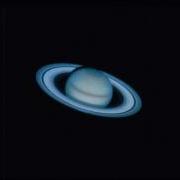Having been so prominent over the last 5 months or so, Jupiter is finally dropping lower down into the west and so is best observed telescopically earlier in the month. The moon lies nearby on the 4th and again on the 31st
Having reached opposition early last month, Mars remains a conspicuous object to the naked eye, residing midway up in the south, upper right of Spica, chief star in Spica. Through a scope Mars exhibits a small orange disk, with a hint of surface detail;- notably the north polar cap. The moon lies nearby on the 10th/11th.
Saturn takes centre stage this month, reaching opposition on the 10th and is therefore visible from sunset to sunrise. You can locate Saturn over in the south-east during late evening and due south by midnight, a conspicuous 'pearly star' a couple of hands spans left of Mars. To view the beautiful rings you will need a telescope, any size will suffice, but larger scopes will reveal more detail, Cassini and Encke gaps, as well as disk detail; banding etc and Saturn's larger moons, most notably Titan , which circles round Saturn twice a month. The moon lies nearby on the 14th.

Mercury bounds back up into the evening twilight sky at the start of May and remains on show until the end. Look to the WNW 45 mins after sunset around 5 degrees above the horizon (width of a hand at arm's length). It is highest around the 19th but is brightest before this. Use binoculars if you cannot initially spot this elusive planet with the naked eye in the bright twilight. The slim crescent moon lies to the left of Mercury and below Jupiter on the 30th. Finally, Venus lingers in the early dawn sky low down in the east before sunrise.
- Log in to post comments

